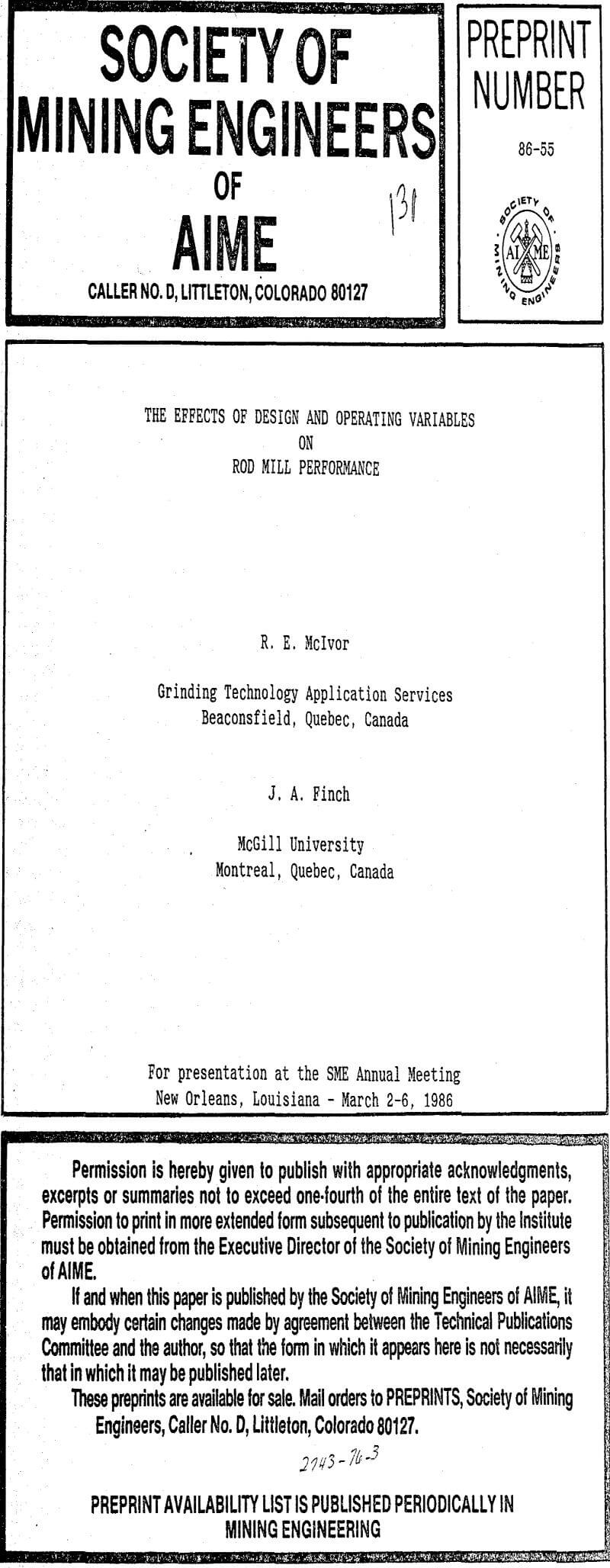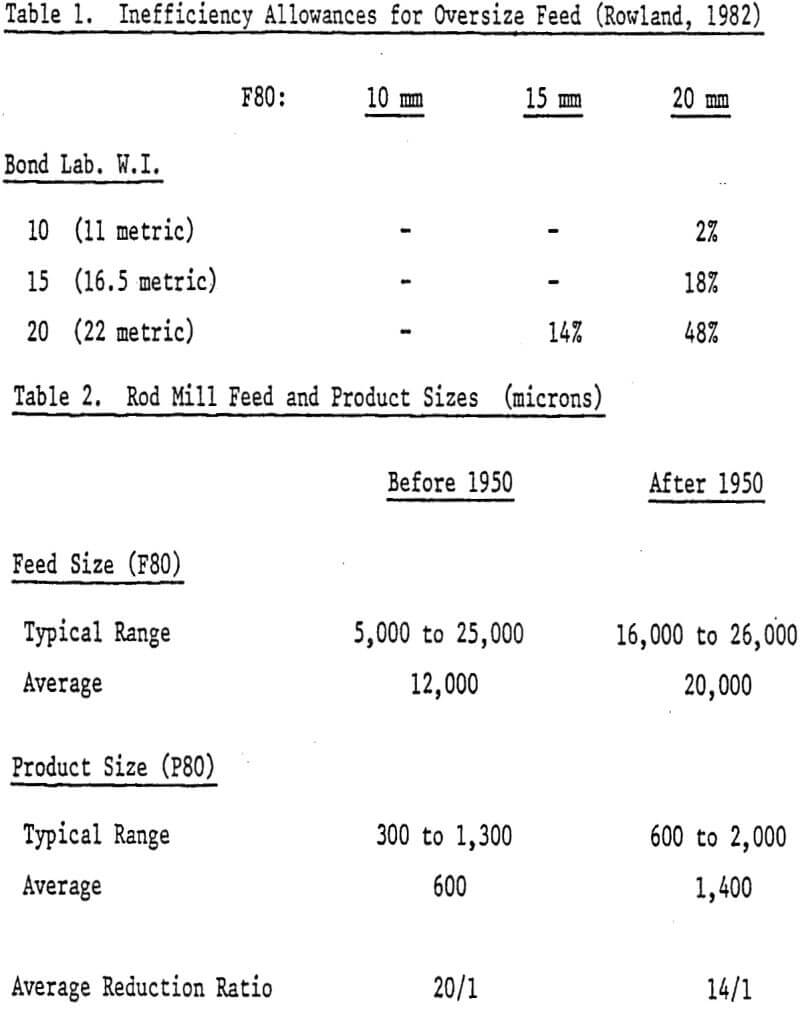There is no reported evidence that feed size has any effect on rod mill power draw. Because the solids in the rod mill are known to appreciably expand the mill charge (as observed in the charge level before and after grinding out the mill), there would likely be a tendency for power draw to be lower with coarser feeds and at higher feed rates. However, loss of power draw due to “overloading” (as sometimes reported in ball mills) or as an indication of an impending rod tangle, has not been observed.
Rod Mill Feed Size & Size Distribution
Typically, feed to rod mills comes from closed circuit crushing with screens with a top size of 1 to 1¼” , or 25 to 32 mm (F80 of 15,000 to 20,000 µm). Deviations above this size have often been associated with extremely poor efficiency, as measured by the Bond Operating Work Index, especially on ores with high Bond Laboratory Work Indexes. This appears to justify Rowland’s (1982) oversize” feed inefficiency factor (see Table 1), as well as an additional overall 20% inefficiency factor for open (versus closed) circuit crushing.
Data from Tennessee Copper show no change in efficiency when bin segregation resulted in a change from zero to almost 10 percent plus one inch (25 mm) material (F80 from 11,000 to 21,000 µm), while a decrease in feed size from F80 equal to 13,000 down to 10,000 µm showed a reduction of about 20% in Operating Work Index at National Lead. At Brunswick Mining an increase in feed size F80 from about 12 to 14 mm actually resulted in a finer circuit product size and 10 to 15 percent lower Operating Work Index.
Although ore grindability generally has not been monitored in plant tests, one can conclude that there is a critical feed size above which rod milling efficiency is lost, most drastically when the size of feed is not controlled by screening. This critical size is smaller for harder ores. When feed size is below this critical size, variations in feed size may have varied effects on circuit efficiency.
Rod Mill Fines Content
The presence of “fines” in open circuit rod mill feed has long been recognized as an important factor for both stable and efficient mill operation. Although addition of extra fines to rod mill feed was common practice in the past, few details have been reported. The fortunate exception is the experience at Frood Stobie. Although initially (and successfully) introduced to reduce rod tangling, careful planning and testwork, which ensured constant ore feed characteristics, proved an average reduction of 15% in Operating Work Index over a wide range of feed rates. Note that at Frood Stobie, pre-washing of crusher plant feed had meant that normal rod mill feed was originally low (approx. 5% minus 200 mesh, or 74 µm), in natural fines content.
It is apparent that the presence of fines has a strong influence on material transport, and therefore the spatial distribution of solids, inside the mill. They may help mill efficiency in a number of ways;

- by helping to carry larger ore pieces into the spaces between the rods at the mill feed end;
- once these pieces are broken, by carrying intermediate and smaller size pieces along the mill length so they can be effectively re-broken.
Note that without (a) and (b), a bottleneck at the feed end could be the factor controlling production rate, and in the extreme, result in rod tangles due to excessive spread of the charge at the feed end. - Near the discharge end, they provide high solids loading of fine material, so that grinding can also take place in this region. The lack of generation of fines in the mill itself may mean that there is not enough naturally produced material to take advantage of this finer grinding region.
- Overall pulp density, and therefore solids content, will be increased throughout the mill, increasing the potential for work done.
Empirical observations, besides successful adoption of the practice at Frood-Stobie and other plants, strongly support fines addition, for example;
The unique position of the rod mill as the first stage of material handling in which gravity is abandoned and a solids/water mixture is adopted would lead one to expect material transport problems similar to those experienced in pumping such materials.
The function of external classifiers, which is to lessen the net amount of fines in mill feed, and their failure to improve the performance of coarse grinding rod mills, supports the contention that rod mills generally function with less than an optimal amount of fines in the feed.
The need for a certain minimum fines content to ensure effective material transport has even been observed in ball milling, where size distributions are already generally much finer than in rod mills.
With the historical trend towards larger, more heavily loaded, coarser grinding units, fines addition to rod mill feed offers extremely interesting potential for grinding performance improvement (see section 6 on closed circuit grinding).
Practical Considerations
Excessively coarse feed may result in excessive wear on both the rods and shell liners at the feed end, and shell liners at the discharge end. This was not noted at Sullivan, where the high mill loading and speed allowed coarse particles to pass through the mill.
Fines removal can contribute to rod tangles. Fines addition, on the other hand, can be used to reduce noise level, rod and liner wear and breakage, liner bolt loosening, and generally to stabilize mill performance .
While fines washing can be advantageous to crusher plant operation, it is to the detriment of rod mill operation, and can create a second problem of unstable plant operation if they are re-introduced on an intermittent basis.

